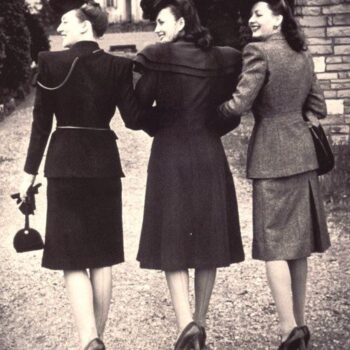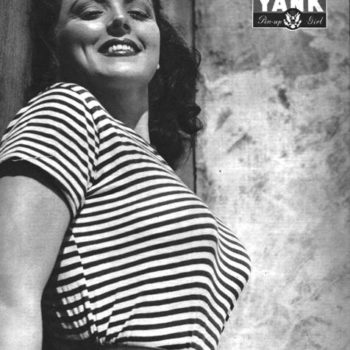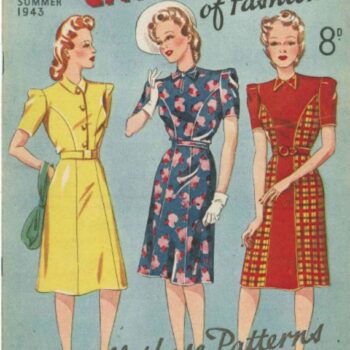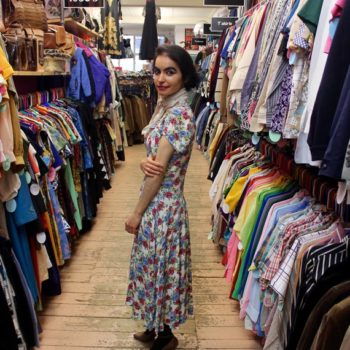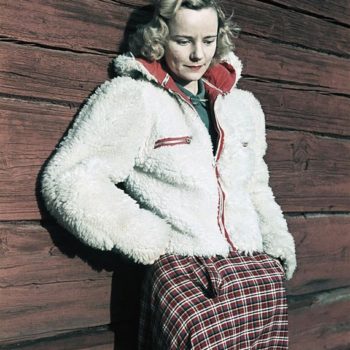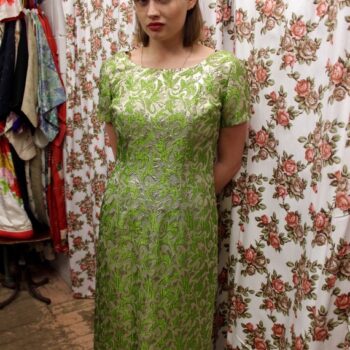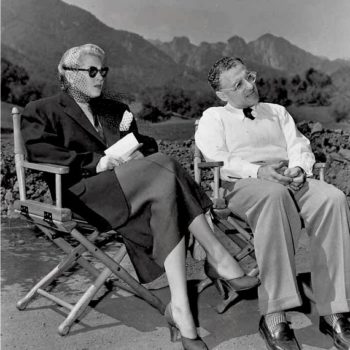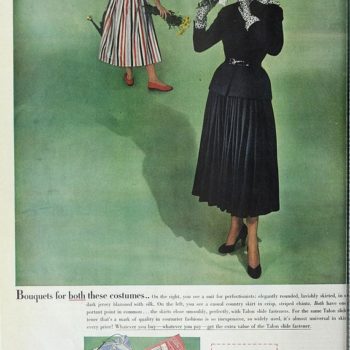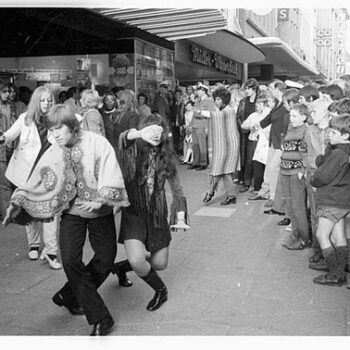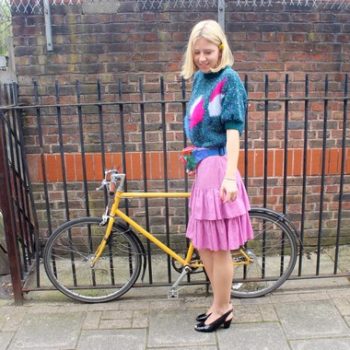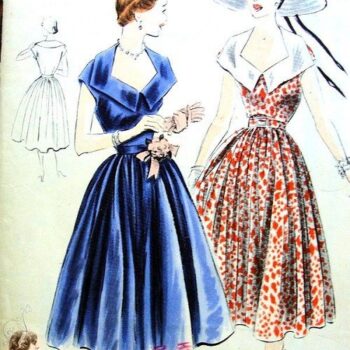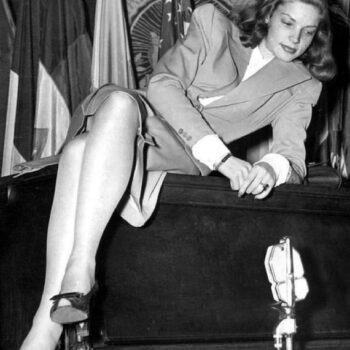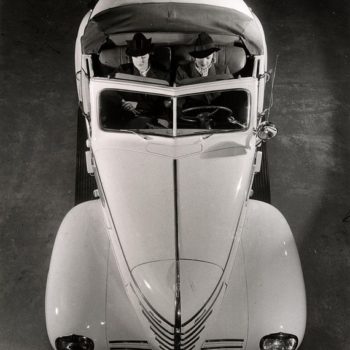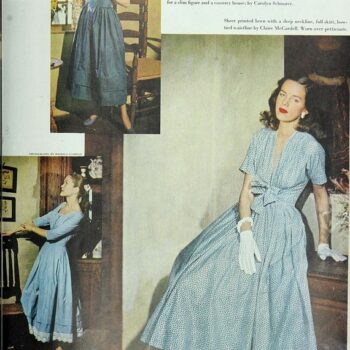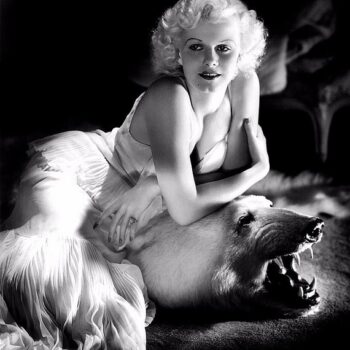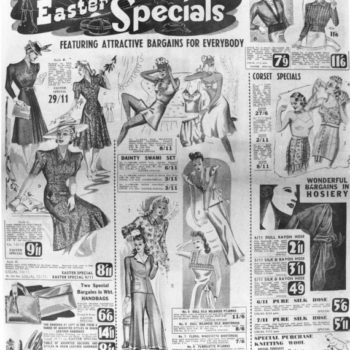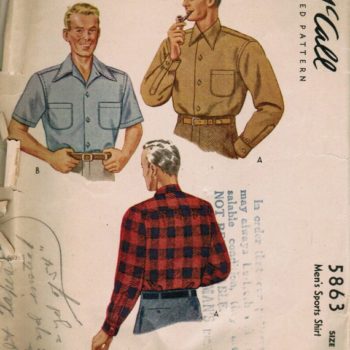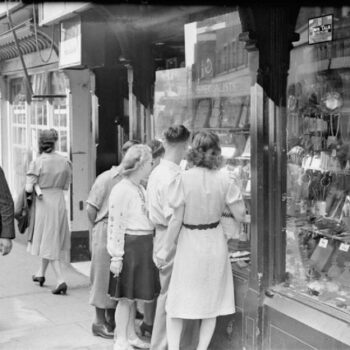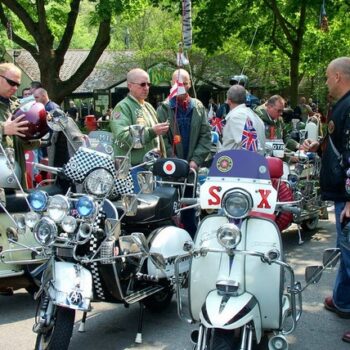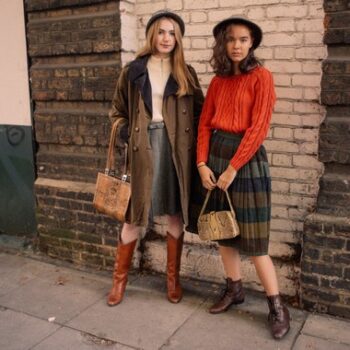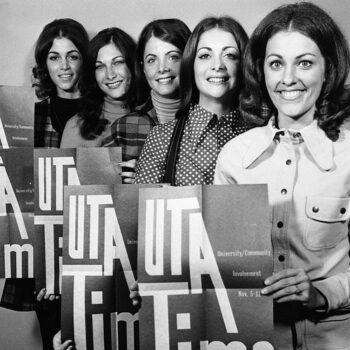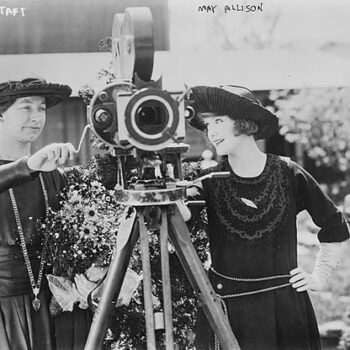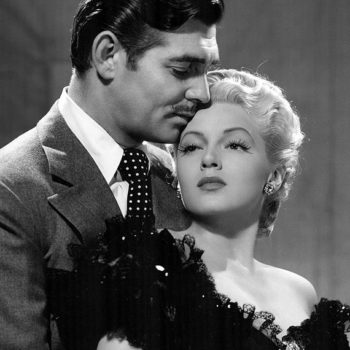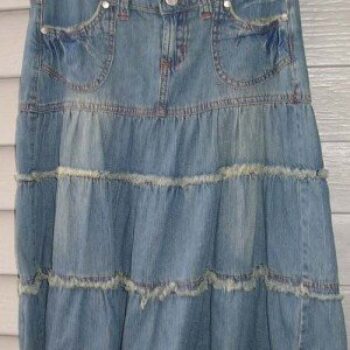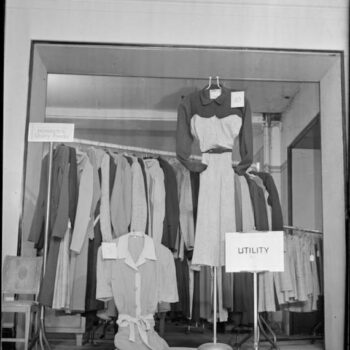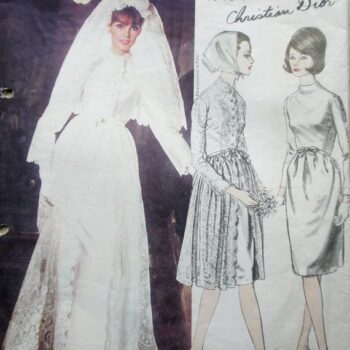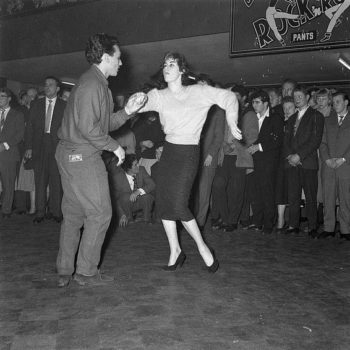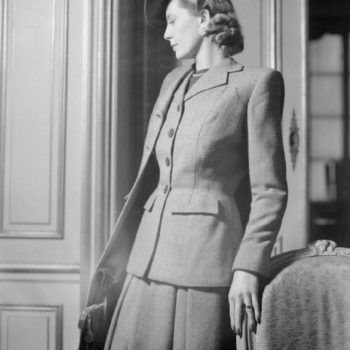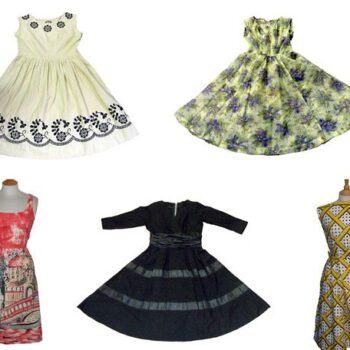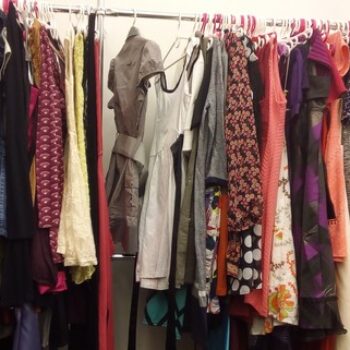Fashion in the 40s: Strength, resilience and ingenuity
February 6, 2019Born in shortages and rationing, fashion in the 40s left an indelible mark, not just on 1940s womens fashion, but on the fashion industry for many decades beyond the 1940s.
Fashion of the 40s was all about trying to make do with less. The world war was taking its toll on resources, and that included fabric and yarn that needed to be diverted to the war effort. It was in this environment that clothing for women reinvented itself, and fashion designers rose to the occasion.
We’ll look back at the rationing and restrictions that brought forward memorable Womens 1940s fashion ideas.
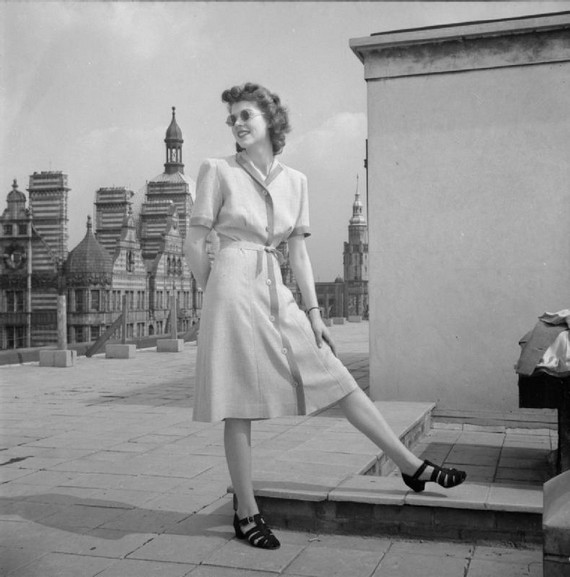
Model, on rooftop, Bloomsbury, London, wearing two-tone Atrima dress, price 7 coupons.
Date : 1943
Utility Clothes and 40 Fashion
Up until the late 1930s, women wore a wide assortment gowns and dresses that took up massive yardage to produce. But then, in the autumn of 1941, clothing was rationed across Britain – and fashion in the 40s changed. The idea was that available fabric and manufacturing capacity be diverted to aid the country’s efforts in the world war.
It was that decision, perhaps, that changed the course of womens clothing for a decade or more thereafter. Some 1940s womens fashion analysts believe that bill CC41, which issued the prohibition on certain types of clothing, ushered in a new chapter in fashion history.
If you love period dresses, then you’ll know exactly what vintage style is all about. Women loved their ankle length skirts and flowing tunics. But the length of women’s dresses wasn’t the only attractive design feature. Unlike fashion in the 40s, the pre-1940s fashion industry promoted a lot of extra embellishments as part of womens fashion essentials. And all of that required extra fabric, thread and other accessories.
The era of utility clothes came in with the introduction of CC41. Fashion in the 40s became one that was less about what women loved, and more about what the law permitted. 1940s style could no longer be about structured shoulders, accentuated waists, bustles and full skirts. Designers had to comply with CC41 provisions or risk the repercussions.
And as the world war ground on, and there seemed no end to the hostilities – and therefore CC41 – was in sight, designers started fashioning clothing for women that was CC41-compliant. Utility clothes defined fashion in the 40s for a decade or more after CC41 was introduced!
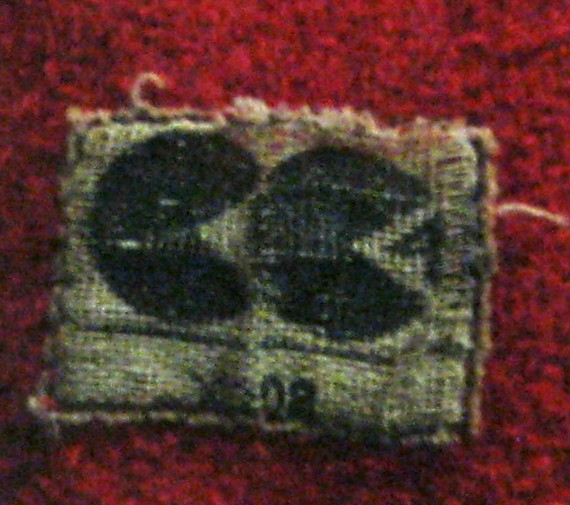
CC41 Label from red coat owned by Mona Roberts, Utility Clothing on display at the Bury Art Museum. Designed by Reginald Shipp.
1940s Style Changes
If you took time to compare what women wore prior to CC41, you’re bound to notice the stark difference in designs and patterns. While pre-1940 vintage style was characterised by an abundance of flair, flow and fabric, that all vanished in the utility clothes look.
Some stark 1940s style changes that women faced included:
-
Skirt lengths
Obviously, with fabric rationing and restrictions on clothing manufacturers to adhere to CC41, ankle length skirts were one of the first victims of change.
As fabric for producing elaborate-length skirts was harder to come by, fashion trends changed to meet the new reality. For the first time, ladies dress designers began to experiment with the idea of knee-length skirts – and it was an instant success. By now, war-weary British women had enough of the dreary, and they were looking for change.
Designers of women’s fashion in the 1940s saw that, and they responded. Higher length skirts were created partly as a result of fabric shortages, but also to reflect the social reality of the times. The war effort meant more women started serving in the workforce, and that changed how clothing for women evolved.
Women wanted to feel “liberated”, and the coveralls, trousers and overalls that women wore at work just didn’t cut it. They wanted to show more skin, though without breaking the bounds of modesty. Designers, like Christian Dior with his New Look, provided them the opportunity to do just that.
The obvious way, to comply with CC41 and give 1940s women what they wanted, was to design dresses with shorter hems. The knee-length skirt was a radical departure from the down to ankle versions. Yet it provided women a touch of femininity that work wear did not.
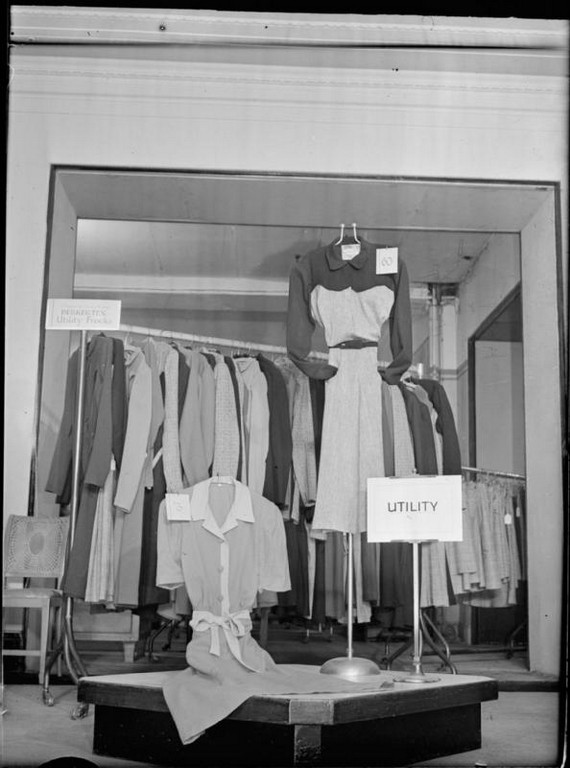
Norman Hartnell designed utitlity clothing dispayed in shop window, 1942
Norman Hartnell designed utitlity clothing dispayed in shop window, 1942
-
Tea dresses for more than evening tea
With the popularity of shorter length skirts came yet another revolution in womens fashion design. To make the war days even more bearable, women needed something more than skirts and tops, especially to socialize and have some fun after work. However, 1940s style designers still needed to comply with CC41, so they decided to give women yet another choice for their wardrobes: a fusion of traditional tea dresses with knee-length hems!
Unlike the drab, plain vintage style dresses that were available pre-1940s, designers opted to bring some life into tea dresses in the 1940s. Brighter colours, flowery patterns and more shapely waistlines were infused into a uniquely 1940s style dress for the evening.
Of course, staying with the utility clothes theme, designers had to also be conscious about the yardage they used to produce their creations. So, along with more radiant tea dresses, they produced them with shorter hemlines too. But that wasn’t the only innovation that the fashion industry had in store for dress loving women of the 1940s.
The pivot from ankle length hems to dresses that terminated just above the knee, prompted design changes further above the waist line too. Women’s dress fashion in the 40s saw designers introduce sleeves that terminated slightly before the elbow. Some tea dresses also had sleeves that ended at mid forearm level.
The cap sleeve, a smallish sleeve on day dresses, was yet another 1940s womens fashion innovation. Once again, because they could be produced with just a simple hem, with no additional sewing required, they fit within the utility clothes guidelines.
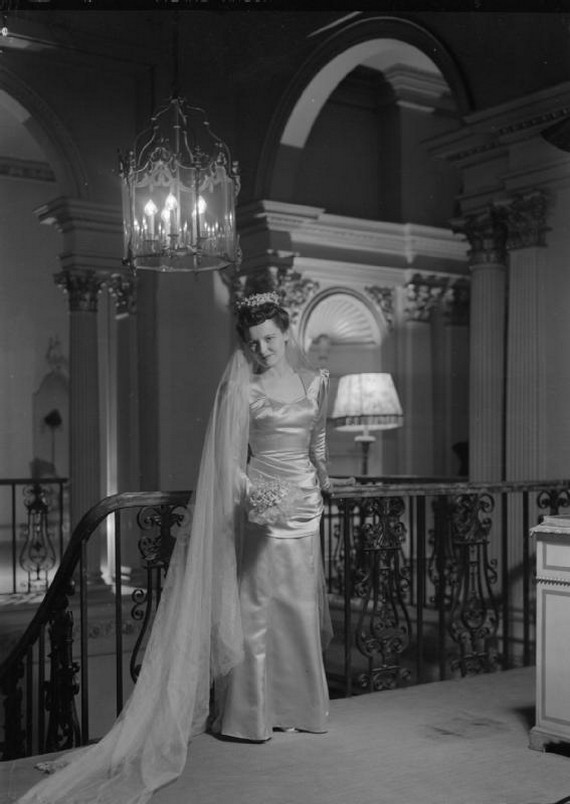
Peggy Bryan models wedding dress designed for her by fashion designer Bianca Mosca. 1945
-
Womens fashion above and beyond
As we look above and beyond the waist and neck, we see that there were other embellishments added to 1940s style.
Unlike vintage style dresses of prior decades, the shoulders of women’s dresses in the 1940s changed too. Since women were now in the workforce in much larger numbers than any previous decade, 1940s women felt more “empowered”. And they needed that to come out in their blouses and day dresses.
1940s fashion trends therefore gravitated towards designs with squarer shoulders and puffy sleeves. A look back at 1940s womens fashion magazines will show flowery patterned dresses with square corner shaped shoulders. That look was infused with the help of shoulder pads. Many later year fashion industry watchers believe that this innovative feature of fashion in the 40s was a precursor to the power shoulder suits that were the hallmark of iconic women like Britain’s Margaret Thatcher and Hollywood’s Joan Collins.
Typically, blouses, shirts and day dresses had higher neck lines. Though 1940s women didn’t fancy plunging necklines like we see today, they still revealed more skin than tea dresses of the previous decade. Commonly, clothing for women in the 1940s featured V necks. However, heart-shaped necks and even square-cut necklines were common too.
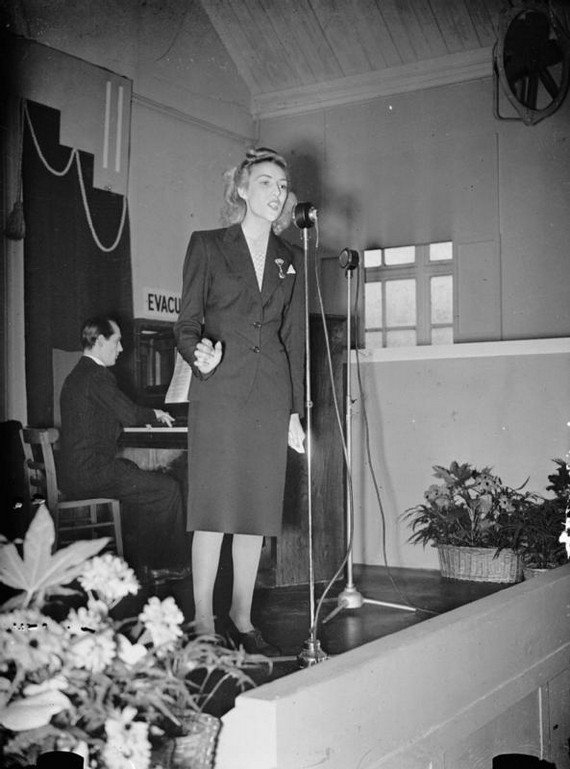
Vera Lynn sings to workers, lunchtime concert at a UK munitions factory,
1941
Re-cycled fashion of the 40s
Never has the fashion industry seen the power of recycling and reusing old wardrobe pieces, as they did in the 1940s. Women made fashion history as they dug into the back of their closets to repurpose vintage style dresses, skirts and tops from previous decades.
Fashion in the 1940s was very much influenced by the government, whose moto of “Make do and mend” resonated with ladies across Britain. Popular fashion industry magazines would unashamedly teach women how to recycle older clothes and create fresh 1940s style pieces out of them.
Since many menfolk were off to war, the recycling craze didn’t just stop with 1930s dresses being made into 1940s tea dresses. Women’s fashion in the 40s soon extended to wives using their husbands suits to fashion 1940s ladies’ outfits for themselves. Womens fashion designers soon caught on, and introduced high-waisted pants especially for women who wanted to transition from knee-length dresses and skirts.
Revamping pre-owned mens and womens clothes
The ingenuity of fabric starved fashion in the 1940s wasn’t limited to just revamping older, gently used or previously owned mens and womens clothes. Household linen was used to create 1940s style dresses and blouses, and old blankets were used to fashion clothing for women, including coats and jackets.
Recycled fashion in the 40s went beyond dresses and trousers. Knitted fashion became a household thing, with women taking older vintage style jumpers and sweaters apart to harvest hard to come by woollen yarn. They then used that raw material to create 1940s style cardigans and pullovers. Recycled and repurposed fashion trends from that era also included knitted slippers, caps and scarves.
But as with prevailing trends, recycled and repurposed fashion in the 40s had to conform to the guidelines for utility clothes available at retail stores: There were stringent limits on turn-ups, pleats and hems.
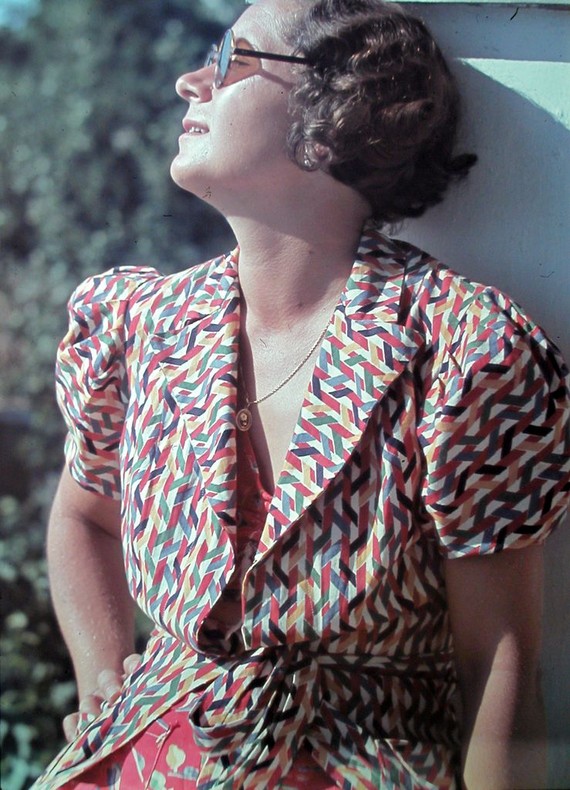
Woman in colourful separates and sunglasses, taking in the Sun, 1943
Combined and Separates
Fashion in the 40s was “modest” at best. Because there wasn’t too much choice in a woman’s wardrobe, women wore the same pieces of clothing frequently, and for more than one occasion. It was something that many women had no choice in, because 1940s womens fashion was minimalistic at heart. And because money was tight, and jobs were hard to come by, you just had to reduce the number of outfits you owned.
But the fashion industry had an answer for that too!
While wearing utility clothes was all fine and good – surely women could use “optical illusion” to make it seem they were still in touch with fashion trends of the time. Until now, combined outfits were what 1940s women wore.
Blue, commonly Airforce or Navy blue – was the colour of the decade. So, calve length skirts and jackets – all in blue, were the perfect combination for women to wear. And then, you would see her in a knee-length grey skirt with a matching grey sweater. These two outfits would see a woman through weeks, as she alternated between grey and blue.
But fashion in the 40s changed when the idea of combining outfits gave way to wearing separates! Why couldn’t women wear blue calve length skirts with a grey sweater one day, and switch to a grey knee-length skirt and blue top the next? Now, instead of two combined outfits, 1940s women had four separate outfits that they could produce.
Fashion in the 40s lives on
Despite mounting odds against it, fashion in the 1940s not only survived the post world war decade but thrived too. Many of the fashion pieces, like peep toe shoes, fashioned out of scarcity of leather from wood and cork, have become “must have” pieces for women today.
1940s style may have started from rationing and shortages, but it will go down in fashion history as a testament to the resilience and ingenuity of 1940s women, and the fashion industry of that time.
Links [i] [ii] [iii] [iv] [v] [vi]
[i] https://www.1940.co.uk/acatalog/an-introduction-to-utility-clothing.html
[ii] https://vintagedancer.com/1940s/1940s-womens-dress-fashions/
[iii] https://vintagedancer.com/1940s/1940s-fashion-history/
[iv] https://www.marieclaire.co.uk/fashion/1940s-fashion-the-decade-captured-in-40-incredible-pictures-108160
[v] https://www.1940.co.uk/acatalog/french-american-and-british-wartime-fashion.html
[vi] https://fashion.just-the-swing.com/1940s-womens-fashion
- Create the Look The Nineteen Forties
- 1940s Womens Fashion – What did women wear in the 1940s
- 1940s Mens fashion
- 1940s Swimwear
- 1940s Stockings
- Vintage 1940s dresses
- 1940s vintage clothing
- womens 1940s vintage clothing
- Women’s 40s fashion – The Wartime Silhouette
- Fashion in film – the 1940s
- Posting Letters to The Moon – Celia Johnson
- Timeless 40s fashion trends make a memorable comeback
- 1940s Dress
- 30s 40s fashion
- 1940s fashion trends
- Mens 40s fashion
- 40s ladies fashion
- 40s Fashion Men
- 40s 50s fashion
- 40s fashion
- The 40s fashion
- 40s Mens fashion
- 19 40s fashion



